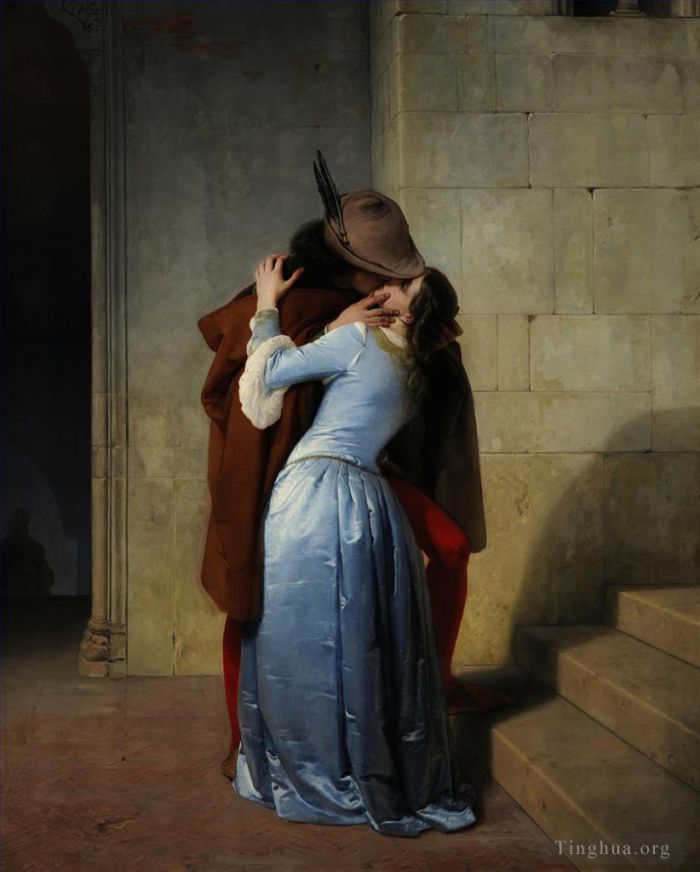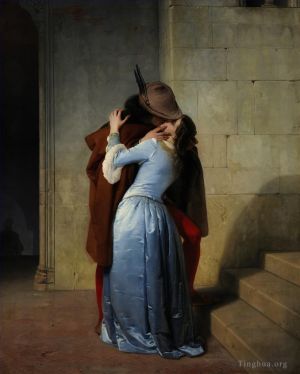The Kiss
Francesco Hayez
- Price: Price on Request
- Art Type: Oil Painting
- Size:
- English Comments: 0
- International Comments: 0
- Creating Date:
- Introduction and Works of Francesco Hayez >>
Keywords:
Kiss
Work Overview
- The Kiss
Artist Francesco Hayez
Year 1859
Medium oil on canvas
Dimensions 110 cm × 88 cm (43 in × 35 in)
Location Pinacoteca di Brera, Milan
Il bacio (Italian pronunciation: [il ˈbaːtʃo]; The Kiss) is an 1859 painting by the Italian artist Francesco Hayez. It is possibly his best known work. This painting conveys the main features of Italian Romanticism and has come to represent the spirit of the Risorgimento. It was commissioned by Alfonso Maria Visconti di Saliceto, who donated to the Pinacoteca di Brera after his death.
The painting represents a couple from the Middle Ages, embracing while they kiss each other. It is among the most passionate and intense representations of a kiss in the history of Western art. The girl leans backwards, while the man bends his left leg so as to support her, simultaneously placing a foot on the step next to him as though poised to go at any moment. The couple, though at the center of the painting, are not recognizable, as Hayez wanted the action of the kissing to be at the center of the composition. In the left part of the canvas shadowy forms lurk in the corner to give an impression of conspiracy and danger.
This painting has been regarded as a symbol of Italian Romanticism, of which it encompasses many features. On a more superficial level, the painting is the representation of a passionate kiss, which puts itself in accordance with the principles of Romanticism. Therefore, it emphasizes deep feelings rather than rational thought, and presents a reinterpretation and reevaluation of the Middle Ages in a patriotic and nostalgic tone.[3]
On a deeper level, the painting aims to portray the spirit of the Risorgimento. The girl's pale blue dress signifies France, which in 1859 (the year of the painting's creation) made an alliance with the Kingdom of Piedmont and Sardinia, enabling the latter to unify the many states of the Italian peninsula into the new kingdom of Italy.
This painting is notable for its vivid colors and textures, in particular the blue dress, which appears to be a beautiful silk which shimmers before the viewer's eyes.
The Kiss has enjoyed extensive popularity from its exhibition onward, especially in Italy, and has been the subject of much commentary. In the 1920s the art director of Perugina, one of Italy's leading chocolate manufacturers, revised the image of the painting and created the typical blue box of the popular "Baci" chocolates with the picture of two lovers. In 1954 the great Italian director Luchino Visconti took inspiration from the painting for one of the leading scenes of his masterpiece movie, Senso.
The canvas was shown at the Brera Exhibition of 1859 which, held a few months after the entry of Victor Emanuel II and Napoleon III into Milan, celebrated the successful conclusion of the struggles of the Risorgimento, but did not enter the Pinacoteca until 1886, as a legacy from Alfonso Maria Visconti, who had commissioned the picture.
It is one of the emblematic images of the Pinacoteca and perhaps the most widely reproduced Italian painting of the whole of the 19th century, created with the aim of symbolizing the love of the motherland and thirst for life on the part of the young nation that had emerged from the Second War of Independence and which now placed so many hopes in its new rulers. It proved an immediate and resounding success both for its patriotic values and for the medieval inspiration of the subject, typical of the Romantic taste of the time: Hayez painted other versions of it, now in various European collections.
In this painting of strong emotional impact, rich with symbolic meaning, Hayez undertakes the theme of separated love.
The work, presented at the Brera exhibition in 1859 a few months after the arrival of Vittorio Emanuele II and Napoleone III in Milan, celebrates the success of the Italian Risorgimento. It immediately became one of the most reproduced works of art during the XIX and XX centuries and it was also cited by Luchino Visconti in the film I.
The Kiss is an admirable example of the Risorgimento style introduced into Italy by Hayez. It was received with immediate acclaim both for its patriotic connotations, because it represented love for the homeland and the young nation’s desire for life, and for its uncontested formal representation.
The superb pictorial skill evident, for example, in the sheen of the satin skirt together with the undeniable fascination of the subject have made this work one of the great symbolic images of the Pinacoteca, where it has been on display since 1886.
The link between the Pinacoteca di Brera and Francesco Hayez constitutes one of the founding characteristics of the location. Hayez taught art in the Accademia di Belle Arti and, nowadays, the Pinacoteca preserves the largest anthology of Hayez’s works in the world boasting, as well as The Kiss, works of art like the Double portrait of the Manzoni couple, Melancholy Thought, Pietro Rossi and The Odalisque.
- Copyright Statement:
All the reproduction of any forms about this work unauthorized by Singing Palette including images, texts and so on will be deemed to be violating the Copyright Laws.
To cite this webpage, please link back here.
- >> English Comments
- >> Chinese Comments
- >> French Comments
- >> German Comments
- >>Report
- Malinconia
- Portrait of Carolina Zucchi
- Portrait Of Alessandro Manzoni
- Jacob and Esau
- Rinaldo And Armida
- Ritratto della contessa luigia douglas scotti d adda
- The Refugees Of Parga
- Caterina Cornaro Deposed from the Throne of Cyprus
- Meditation On The History Of Italy
- Nudo di donna stante 1859
- The Penitent Magdalene
- The Last Kiss of Romeo and Juliet
- Carlotta Chabert come venere 1830
- Italia romanticismo
- Crusaders Thirsting Near Jerusalem
- The Kiss
- Lot and His Daughters
- Ruth 1835
- Laocoon
- Susanna at her Bath









 Singing Palette
Singing Palette